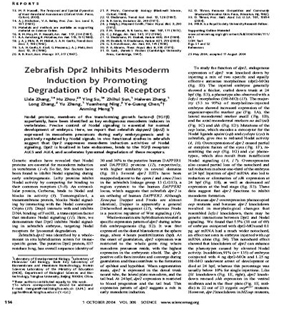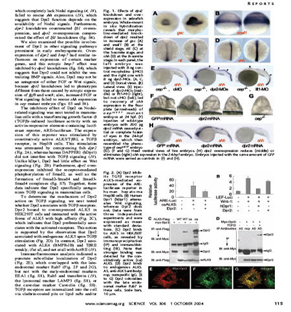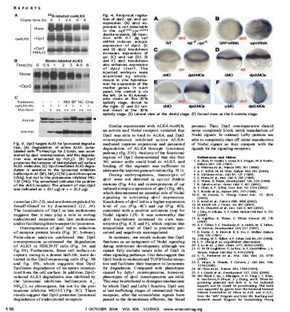-A novel mechanism inhibiting mesoderm induction in animal embryos

The 1st of October issue of Science published a paper by researchers at Department of Biological Sciences and Biotechnology in TsinghuaUniversity, entitled “Zebrafish Dpr2 Inhibits Mesoderm Induction by Promoting Degradation of Nodal Receptors.”
 As a collaborative product of Dr. Anming Meng’s Developmental Biology Laboratory and Dr. Ye-Guang Chen’s Molecular Cell Biology Laboratory, this paper describes a novel mechanism blocking mesoderm induction activity of transforming growth factor (TGF) b signals.
As a collaborative product of Dr. Anming Meng’s Developmental Biology Laboratory and Dr. Ye-Guang Chen’s Molecular Cell Biology Laboratory, this paper describes a novel mechanism blocking mesoderm induction activity of transforming growth factor (TGF) b signals.
Animals, including human, are developed from a single-cell embryo through complicated processes. Formation of tissues and organs during embryonic development involves many tightly regulated processes, such as cell proliferation, differentiation and migration. If any of them goes wrong, an embryo will be malformed, develops into an adult with diseases, or even dies. Nodal signal of the TGFb superfamily plays a key role in induction of mesoderm during embryonic development. Previous studies disclose that in order to avoid excessive amount of mesodermal tissues, antagonists of the Nodal signal are produced by an embryo and they inhibit the Nodal activity mainly by binding to positive components of the Nodal signaling pathway.
Are there other mechanisms in which the Nodal signal is inhibited? The researchers at TsinghuaUniversity identified a zebrafish gene dpr2 that is specifically expressed in mesodermal precursor cells of early embryos. They found that inhibition of Dpr2 resulted in increase of mesodermal tissues and in contrast its over-expression led to decrease of those tissues.Further biochemical studies revealed that Dpr2 proteins bound to activated and internalized Nodal/TGFb receptors and promoted their degradation in lysosomes. These findings indicate that mesoderm induction activity of the Nodal signal can be controlled by regulating degradation rate of the Nodal receptors.
Dr. Meng said: “Different vertebrate species have similar developmental processes and adopt some common mechanisms. Zebrafish is a vertebrate species, and the mechanisms revealed in zebrafish can be applied to other species. Besides, considering involvement of TGFb signaling in proliferation and migration of tumor cells, we have an interest in investigating the potential role of Dpr2 in development of tumors in the future.”
It is known that the work was done wholly in China and this achievement was the result of close collaborations between laboratories. As pointed out by Dr. Chen, it was impossible to finish this important work without their close collaborations. Collaborations between research groups need to be encouraged in China.


